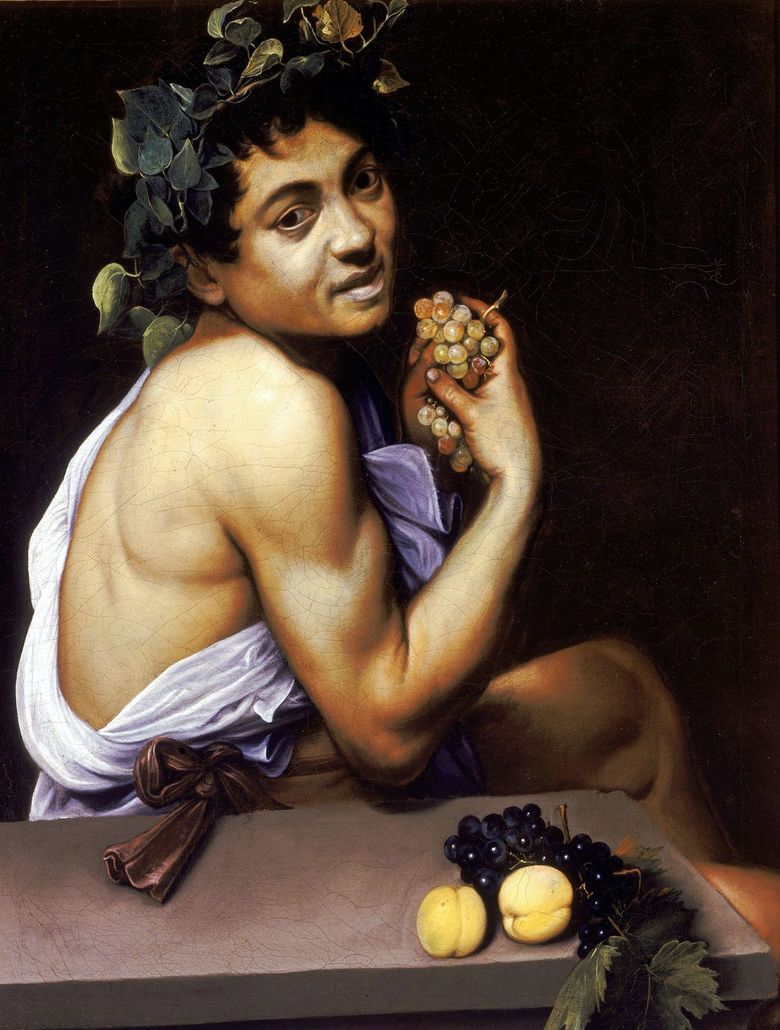
Michelangelo da Caravaggio – an Italian artist who was one of those who first started working in the picturesque Baroque style, wrote “Bacchus” in a fairly calm and serene period of his life. This can be assumed on the basis of the fact that this character Caravaggio drew earlier, but not full of strength, a young man, and the sick and somewhat shabby peasant with a drunk face.
The picture is a portrait of a young man in the image of the Greek deity Bacchus. He is dressed, or rather, half dressed in white robes, belted with a black girdle, the end of which Bacchus holds in his right hand. With his left hand he holds out a wide glass full of wine, as if offering the spectator to take part in a feast. On the table in front of the deity is a bowl of fruit and a pot-bellied bottle of wine.
Bacchus is healthy and muscular, his cheeks are glowing with a blush of a healthy, unburdened person. But his face is plump and somehow feminine, there is nothing in the glance except a half-drunken languor, which is unknown in what can result in – whether in a fight with mythical drinking companions, or in a dream among the utensils utensils. The black resinous hair of the young man looks artificial, which may be true – there are references to the use of wigs by the artist.
Bacchus sits on a white veil, but it does not block a long-stained stripped pillow – a symbol of some uncleanness. The young man’s hand holding the glass probably did not wash for a long time, and dirt accumulated under the fingernails – it is more like the hand of a ragwort than the hand of an ancient deity.
Fruit on the table for the most part are suitable only for ejection – they are crushed, bitten, and some of them rotted and spoiled by caterpillars. Lying among them, a garnet that has lost its market appearance is a symbol of the loss of purity and innocence.
 Bacchus by Caravaggio
Bacchus by Caravaggio Patient Bacchus by Michelangelo Merisi and Caravaggio
Patient Bacchus by Michelangelo Merisi and Caravaggio Girl with a lute by Michelangelo Merisi da Caravaggio
Girl with a lute by Michelangelo Merisi da Caravaggio John the Baptist by Michelangelo Merisi da Caravaggio
John the Baptist by Michelangelo Merisi da Caravaggio A boy with a basket of fruit by Michelangelo Merisi da Caravaggio
A boy with a basket of fruit by Michelangelo Merisi da Caravaggio St. Jerome behind the book by Michelangelo Merisi and Caravaggio
St. Jerome behind the book by Michelangelo Merisi and Caravaggio Fruit Basket by Michelangelo Merisi and Caravaggio
Fruit Basket by Michelangelo Merisi and Caravaggio Bacchus malade – Michelangelo Merisi da Caravaggio
Bacchus malade – Michelangelo Merisi da Caravaggio